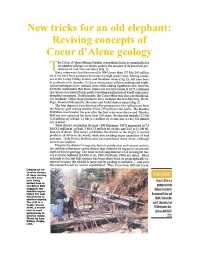Mining Publication: New Tricks for an Old Elephant: Revising Concepts of Coeur d'Alene Geology
Original creation date: January 1998
The Coeur d'Alene Mining District of northern Idaho is remarkable for its number of large ore bodies and for the amount of its historical production of lead, zinc and silver. Since veins were first discovered in 1884, more than 127 Mt (140 million st) of ore have been produced from narrow, high-grade veins. Mining continues at the Lucky Friday, Galena and Sunshine mines. All have been in production for decades. At these mines, more efficient mining and exploration techniques have reduced costs while adding significant new reserves. Even the old Bunker Hill Mine, where ore was first found in 1875, continues operation on a limited basis, partly involving production of world-class pyromorphite specimens. Until recently, the Coeur Mine was also a profitable silver producer. Other large producers have included the Star-Morning, Hecla, Page, Standard-Mammoth, Hercules and Gold Hunter mines.
Authors: BG White
See Also
- 60 Years of Rockbursting in the Coeur D'Alene District of Northern Idaho, USA: Lessons Learned and Remaining Issues
- Assessment of Methane Hazards in an Anomalous Zone of a Gulf Coast Salt Dome
- Coal Mine Geology in the U.S. Coal Fields: a State-of-the-art
- Investigation of a Rock-Burst Site, Sunshine Mine, Kellogg, Idaho
- Investigation of Methane Occurrence and Outbursts in the Cote Blanche Domal Salt Mine, Louisiana
- Managing Excess Gas Emissions Associated with Coal Mine Geologic Features
- Pillar Mechanics of Coal Mine Bursts: A Control Strategy
- Rib Stability: Practical Considerations to Optimize Rib Design
- Site-Specific and Regional Geologic Considerations for Coalbed Gas Drainage
- Technology News 526 - Proceedings of the International Workshop on Rock Mass Classification in Underground Mining
- Content source: National Institute for Occupational Safety and Health, Mining Program


 ShareCompartir
ShareCompartir
